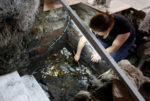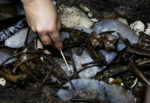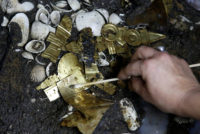 Excavations in Mexico City run into momentous finds every other week, it seems. It’s like Rome. As soon as anyone puts a shovel a couple of feet into the ground, they bump into a treasure trove of the city’s ancient history. The latest announcement is of a discovery made by archaeologists in April of this year: the remains of a sacrificial wolf literally draped in gold. The final tally is 22 intact pieces of jewelry made from thin sheets of gold elaborately decorated with symbols. Most were pendants, the tie that held them together long since decayed; there’s also a nose ring and a chest plate.
Excavations in Mexico City run into momentous finds every other week, it seems. It’s like Rome. As soon as anyone puts a shovel a couple of feet into the ground, they bump into a treasure trove of the city’s ancient history. The latest announcement is of a discovery made by archaeologists in April of this year: the remains of a sacrificial wolf literally draped in gold. The final tally is 22 intact pieces of jewelry made from thin sheets of gold elaborately decorated with symbols. Most were pendants, the tie that held them together long since decayed; there’s also a nose ring and a chest plate.
 The wolf was about eight months old when it was ritually killed. Its body was adorned with gold ornaments and a belt of shells from the Atlantic. It was then placed on a bed of flint blades inside a stone box and buried near the staircase of the Templo Mayor (behind the colonial-era Metropolitan Cathedral), the primary center of worship in the sacred precinct of Aztec Tenochtitlan. It was buried facing west and was meant to represent Huitzilopochtli, the Aztec god of war and of the sun. Archaeologists found layers of offerings in the burial pit, items representing air, earth and sea and laden with religious meaning.
The wolf was about eight months old when it was ritually killed. Its body was adorned with gold ornaments and a belt of shells from the Atlantic. It was then placed on a bed of flint blades inside a stone box and buried near the staircase of the Templo Mayor (behind the colonial-era Metropolitan Cathedral), the primary center of worship in the sacred precinct of Aztec Tenochtitlan. It was buried facing west and was meant to represent Huitzilopochtli, the Aztec god of war and of the sun. Archaeologists found layers of offerings in the burial pit, items representing air, earth and sea and laden with religious meaning.
 In forty years of excavations around the Templo Mayor area in Mexico City’s Zocalo, or central square, the gold covering this little wolf is far and away the finest in both metal quality and in its crafting. More than 200 ritual sacrifices and offerings have been found over the four decades. Only 16 of them contained gold, and little wonder since the Cortes and his successors took every last atom of Aztec gold they could find and melted it down for the Spanish treasure ships. Looters, both deliberate (treasure hunters) and incidental (workmen stumbling on something and pocketing it for sale on the black market), despoiled what was left underground. The Aztec, famous for their prized gold work, have been archaeologically denuded of it in Mexico City, the modern city built over their great capital of Tenochtitlan.
In forty years of excavations around the Templo Mayor area in Mexico City’s Zocalo, or central square, the gold covering this little wolf is far and away the finest in both metal quality and in its crafting. More than 200 ritual sacrifices and offerings have been found over the four decades. Only 16 of them contained gold, and little wonder since the Cortes and his successors took every last atom of Aztec gold they could find and melted it down for the Spanish treasure ships. Looters, both deliberate (treasure hunters) and incidental (workmen stumbling on something and pocketing it for sale on the black market), despoiled what was left underground. The Aztec, famous for their prized gold work, have been archaeologically denuded of it in Mexico City, the modern city built over their great capital of Tenochtitlan.
 This small wolf burial, therefore, is of oversized historical importance as well as great pecuniary and artistic value. It came very close to disappearing from the archaeological record before it was ever documented. A city sewage line built in 1900 interfered with the burial, damaging the box. Thankfully the contents were not exposed, because one little glint of gold and the crew would have helped themselves to all of it, leaving nothing but scattered bones.
This small wolf burial, therefore, is of oversized historical importance as well as great pecuniary and artistic value. It came very close to disappearing from the archaeological record before it was ever documented. A city sewage line built in 1900 interfered with the burial, damaging the box. Thankfully the contents were not exposed, because one little glint of gold and the crew would have helped themselves to all of it, leaving nothing but scattered bones.
The golden wolf was buried during the 1486-1502 reign of King Ahuitzotl, the most feared and powerful ruler of the Mexica, who extended the empire as far south as present-day Guatemala. The reign of Ahuitzotl was particularly brutal, which may also explain the fate of the young wolf.
[Lead archaeologist Leonardo] Lopez said tests on its ribs will be needed to confirm his theory that the animal’s heart was torn out as part of the sacrifice, just as captured warriors were ritually killed on blood-soaked platforms of Aztec temples.
But this was no ordinary violence, noted [Harvard historian and Aztec expert David] Carrasco.
“These people didn’t just kill these things. They didn’t just kill people and throw them away,” he said. “They took elaborate, symbolic care for them because they knew that the presence that they represented, the presence of god, had to be nurtured.”

